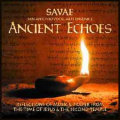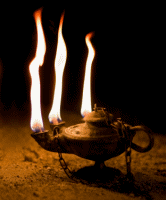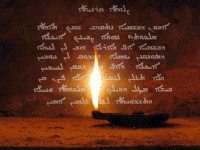Lords Prayer (English)
Our Father who art in Heaven,
Hallowed be Thy Name.
Thy Kingdom come, Thy Will be done,
On earth as it is in Heaven.
Give us this day our daily bread,
And forgive us our trespasses (debts) as we forgive those who trespass
against us (our debtors).
And lead us not into temptation, but deliver us
from evil.
For thine is the Kingdom and the Power and the Glory forever.
Amen.

![]() Double click white box to pause or play
Double click white box to pause or play
*** will not play in IE
Plays in every other browser…
The Aramaic Prayer of Jesus
Lords Prayer in Original Aramaic
tseby o-nokh, aykano d’bvash’mayo of -ba’r‘o. Habv lan lahma d’sunqonan
yow-mano, Washboqlan hawbén w’kh-t’hén, aykano dof h’nan shba-qn l’hayobén. W’lo
tahlan l’nesyun’eh, elo patson men bisho. Metol d’dilok hi malkutokh, w’haylo,
w’teshbuh-to lo‘alam ‘o-l’min.
An Introduction by Mark Hathaway
 To truly enter another culture means trying to understand the way people think and how they view the world. It also means letting go of some of our own established ways of seeing and conceiving.
To truly enter another culture means trying to understand the way people think and how they view the world. It also means letting go of some of our own established ways of seeing and conceiving.
To a large extent, culture is embodied in language. When we think, we normally frame our thoughts in words. Each language has its own unique way of doing this which affects how we see things. So, learning a new language is in some sense learning a new way of perceiving reality. That’s one reason it can be so difficult, and so different from other forms of learning..
Jesus himself lived in a culture very different from our own, and to some extent that is revealed in the language he spoke; Aramaic (sometimes also referred to as Syriac) is a Semitic tongue closely related to both Hebrew and Arabic. It is still spoken today in a few isolated parts of Iraq and Syria, although it is gradually disappearing. It is also used as a liturgical language in several Eastern-rite Catholic and Orthodox Churches.
In some sense, by entering into the Aramaic language, we look through the lens that Jesus himself used to perceive reality. As the tongue of peoples who worked the land, it employs imagery close to the earth and all growing things. It is also a language allowing for multiple possibilities to be present at the same time.. For these reasons, some have observed that it is much closer to the languages of aboriginal peoples than to those of modern western cultures. Indeed, it might help us to understand Jesus better to think of him as a native Middle-Eastern person.
Unfortunately, most of us (myself included) do not speak Aramaic; probably, we have never even heard it spoken. A few words of it do appear in our translations of the New Testament (for instance, talitha kum in Mark 5:41 and maran atha in 1 Cor. 16:22). More importantly, though, Aramaic texts of Jesus’ words have been preserved by the Eastern churches. While scripture scholars usually maintain that the New Testament was written first in Greek, there are good reasons to believe that the Aramaic text (known as the Peshitta) may more accurately reflect the words which Jesus himself spoke. This is especially true in the case of the prayer we call the “Our Father”, which was no doubt prayed by Aramaic-speaking Christians on a regular basis and preserved carefully in oral tradition until the time the written text emerged..
The prayer which Jesus himself taught us is at the heart of our spirituality. By reflecting on the text in Aramaic, many possible meanings come to light. The common translation we use is limited simply because it is but one of many possibilities. In Aramaic, each word can evoke an entire family of images and nuances. The following reflections on each phraseof the prayer, then, meditate on some of the more subtle dimensions present in Aramaic.
* * * * * * * * *
Abwoon d’bwashmaya (“Our Father who art in heaven”) elicits the image of creation, of giving birth to the universe. Abwoon can indeed be translated as “father”, but it can equally be rendered as the word for parenting (in either a physical or spiritual sense). At another level, it presents the image of the divine breath (spirit) flowing out of oneness, creating the whole diversity of forms.D’bwashmaya conjures the images of light, sound, and vibration spreading out and pervading all. In essence, then, “heaven” is conceived not so much as a place as a dimension of reality that is present everywhere.
Some possible renditions of this phrase in its totality would be: “O Source of the Radiance, dancing in and about all-that-is” or “O creative breath, ebbing and flowing through all forms.” Again, these are just examples of the many possibilities that exist simultaneously in the original text (which includes as well the translation we normally pray). Still, they challenge us to be open to new ways of conceiving of both God and heaven.
Nethqadash shmakh (“Hallowed be thy name”) presents the image of someone bending over to clear a space where the sacred may dwell. Shmakh is derived from the same root as the Aramaic word for heaven; it means both name and the concrete manifestation of creative energy. The phrase in its entirety could be: “Soften the ground of our being, and hallow a space for the planting of your presence” or “Free us from all constrictions, so that the current of your life may move in us without hindrance.” We are invited here to let go of all which keeps God from entering our lives, to sweep clean the chamber of our heart. Jesus’ symbolic clearing of the temple resonates strongly with this image. To what extent do we have a marketplace in our own beings? What clutters the space where God desires to dwell within us?
Making room for the sacred prepares us for the next step: Teytey malkuthakh (“Thy kingdom come”). Malkuthakh is a very rich word, and one central to Jesus’ message. While normally translated as “kingdom”, its roots are actually feminine (so “queendom” might be more accurate!). It conveys the idea of guiding principles, of that which empowers us to go forward in the face of all difficulties, and of a creative potential ready to be realised. To me, it evokes the image of the fragile blade of grass that slowly breaks apart the hardest of concrete. Teytey implies a certain urgency in the coming, or a vision waiting to be fulfilled. The image is that of a nuptial chamber, a place of new beginnings. The phrase could be rendered, then, as “Fill us with thy creativity, so that we may be empowered to bear the fruit of your vision” or “In our depths, sow your seed with its greening-power, so that we might be midwives to thy Reign.” This part of the prayer calls us to walk through life with a royal dignity, ready to face difficulties with creativity and hope.
Nehwey tzevyanach aykanna d’bwashmaya aph b’arha (“Thy will be done on earth as it is in heaven”) can be considered the heart of Jesus’ prayer. The “will” referred to here connotes a deep desire causing one’s whole being to move toward a goal with the certainty that the effort will bear fruit. In some sense, it is living as though God’s vision were already a reality. “Earth” (arha) carries a strong feeling of solidity and support; it is something that is fully materialised. Here, then, we pray that the sense of “I can” expressed in the line above be put fully into action. The phrase in its entirety could be: “Let each of our actions bear fruit in accordance with your desire.” or “Moving to the heartbeat of your purpose, make us the embodiment of your compassion.” In essence, we pray that all we do be an act of co-creation with God.
Hawvlan lachma d’sunqanan yaomana (“Give us this day our daily bread”) asks, not only for bread in the physical sense, but also for all that we need to truly thrive. In Aramaic, the word for “bread” (lachma) is directly related to the word for “wisdom” (hochma). We ask that it be given, but also that it be brought forth from the very depths of our own selves. In sum, we pray: “Endow us with the wisdom to produce and share what each being needs to grow and flourish” or “With passion and soul, let us generate from within that which is needed to sustain life this day.”
Washboqlan khaubayn (wakhtahayn) aykanna daph khnan shbwoqan l’khayyabayn (“And forgive us our debts as we forgive those who are in debt to us”) conveys the idea of untying the knots of past mistakes. To forgive is to return things to their state of original freedom. This is something well described in the Old Testament in terms of the Jubilee year where all is returned to its original owners. We are called in this line to let go of all that holds us back from the fulfilment of God’s desire: our failures, our despair, our frustrations. A good translation might be: “Untie the tangled threads of destiny which bind us, as we release others from the entanglement of past mistakes” or even “Empty us of frustrated hopes and desires, as we restore others to a renewal of vision.” Certainly this part of the prayer calls us as well to forgive debts in the economic sense. As a missioner, though, I especially like the idea of letting go of frustrations and restoring a sense of vision. In a world where change sometimes seems impossible, we are challenged to constantly renew our hope and to animate those who have fallen into despair.
In the line Wela tahlan l’nesyuna, ela patzan min bisha (“And do not put us to the test, but deliver us from evil”), we pray that we not let ourselves be distracted from the true purpose of our lives by that which is essentially trivial; we ask that we not be seduced by superficiality and materialism.
In Aramaic, “evil” (bisha) is conceived in terms of an action which is unripe, of a fruit that is either immature or rotten. This calls us to be sensitive to the moment at hand, to carry out the right action at the right time. Hence, we pray: “But let us not be captive to uncertainty, nor cling to fruitless pursuits” or “Do not let us be seduced by that which would divert us from our true purpose, but illuminate the opportunities of the present moment.”
The final line recapitulates the whole prayer: Metol dilakhie malkutha wahayla wateshbukhta l’ahlam almin, ameyn (“For the kingdom, the power, and the glory are yours, now and forever, amen.”) The word translated as “power” (hayla) is the energy that gives and sustains all life. “Glory” (teshbukhta) evokes the image of things returned to a state of harmony and equilibrium. The phrase could be rendered as: “For you are the ground of the fruitful vision, the birthing-power, and the fulfilment, as all is gathered and made whole once again.”
Meditating on the Aramaic version of Jesus’ prayer can be very challenging, precisely because it calls us to re-examine and re-think our spirituality. The images evoked call us to a very down-to-earth life of prayer. They also touch us at a profound level, stimulating us to live more simply, more authentically, and more justly. Yet, the prayer also recognises that conversion is a continuing process, something that must be entered into on a daily basis. During this Lenten season, perhaps we can endeavour to deepen this process in special way.
* * * * * * * * *
This article has been adapted from an earlier version first published in Scarboro Missions magazine. For more information on the Aramaic Lord’s Prayer, please refer to the work of Saadi Neil Douglas-Klotz at www.abwoon.com You may also read several possible “renderings” of the Aramaic prayer written by Mark Hathaway, based on his studies with Saadi Neil Douglas-Klotz, by going here.
Mark Hathaway is an author, web designer, and freelance “ecologian” studying the inter-relationships between ecology, economics, spirituality, and cosmology.
Those interested in learning more about the Aramaic version of Jesus’ sayings should read Prayers of the Cosmos by Neil Douglas-Klotz (Harper and Row, 1990).
Abwoon (Father-Mother of the Cosmos)
The Aramaic Lord’s Prayer, Matthew 6:9-13 and Luke 11:2-4
Chant composed in the ancient Dorian mode by Christopher Moroney · Improvised solo by Covita Moroney
Aramaic is a Middle Eastern language
that was the native tongue of Jesus of Nazareth, and common to the
Israel/Palestine region during the first century c.e. This musical setting of
the prayer of Jesus—sometimes called the Lord’s Prayer—includes traditional
Middle Eastern percussion, rhythms, and improvisational modal chanting. All the
Semitic Languages — including Hebrew, Aramaic, and Arabic — use a root system
which allows one word to hold multiple meanings. Thus, a tradition of
translation arose in the Middle East that led to each word of a prophet being
considered on many different levels of meaning.Abwoon d’bvashmayo, nethqadash shmok. Te-the malkutokh. Nehwé
tseby o-nokh, aykano d’bvash’mayo of -ba’r‘o. Habv lan lahma d’sunqonan
yow-mano, Washboqlan hawbén w’kh-t’hén, aykano dof h’nan shba-qn l’hayobén. W’lo
tahlan l’nesyun’eh, elo patson men bisho. Metol d’dilok hi malkutokh, w’haylo,
w’teshbuh-to lo‘alam ‘o-l’min. Amén. O Birther!Father-Mother of the Cosmos,
focus your light within us.
Create your reign of unity now. Your one desire then acts with ours, as in all light, so in all forms.Grant what we need each day in bread and insight. Loose the cords of mistakes binding us, as we release the strands we hold of others’
guilt. Don’t let surface things delude us, but free us from what holds us back.
From You is born all ruling will, the power and the life to do, the song that beautifies all, from age to age it renews.Truly—power to these statements—may they be the ground from which all our actions grow.
Amen.
(Translation and commentary from Aramaic Peshitta by Neil
Douglas-Klotz, from “Desert Wisdom”- ©1995 Reprinted with permission, all rights reserved, Abwoon Study Circle, www.abwoon.org)





